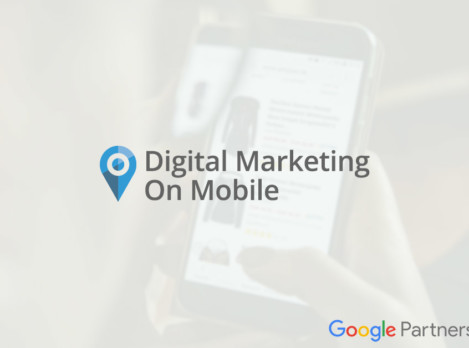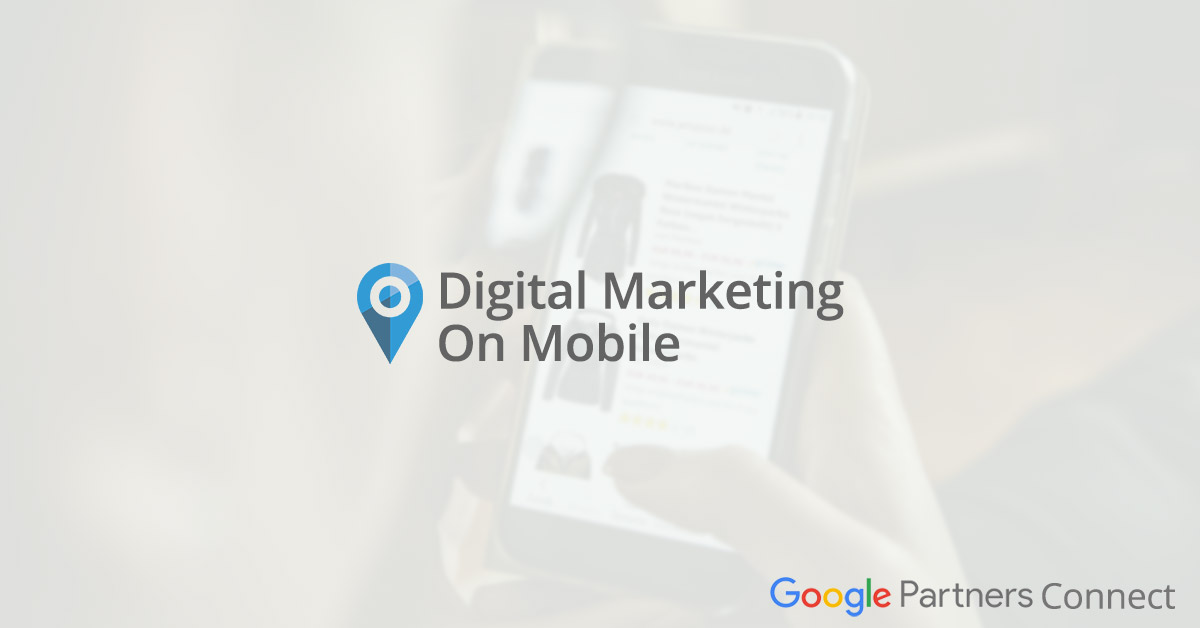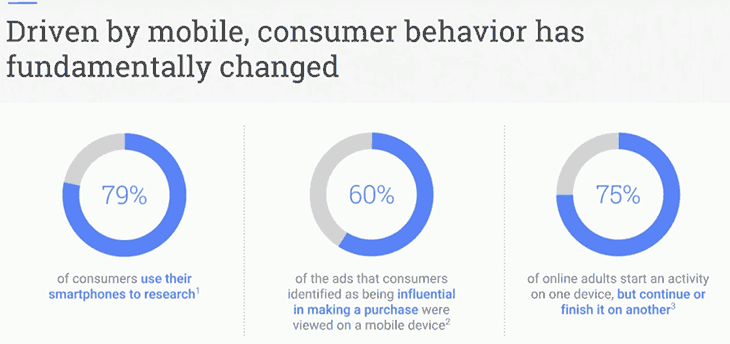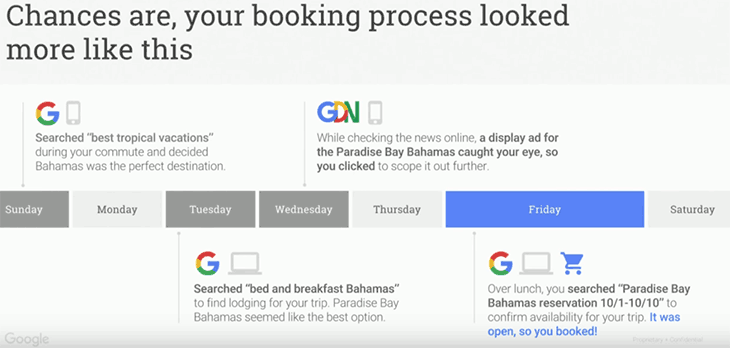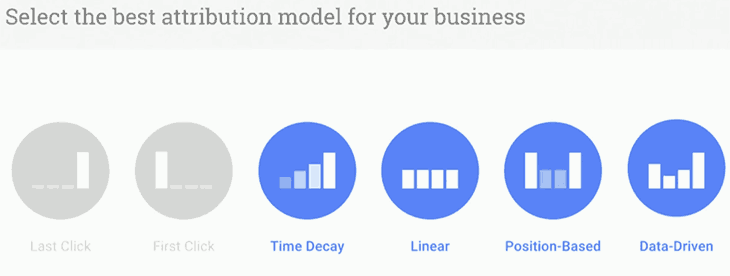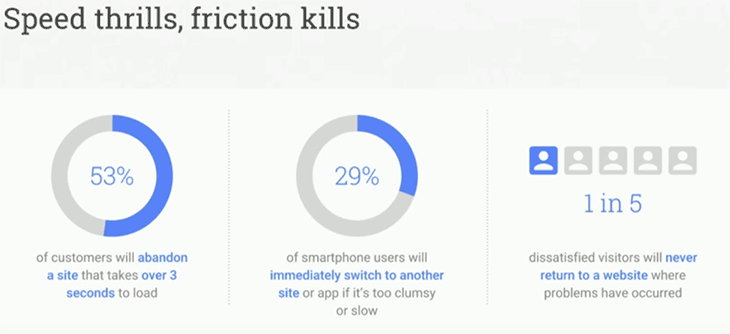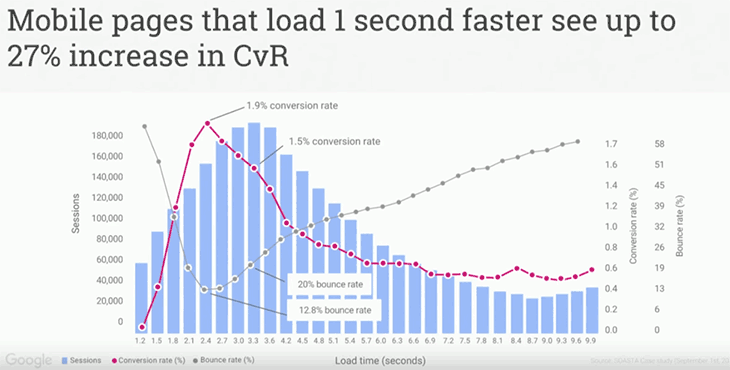On November 15, 2017, Ontario SEO hosted another great Google Partners Connect event that focused on driving business growth with digital marketing for mobile devices. Jimmy Morrow, Global Mobile Lead at Google, and Erin Sagin, Global Go-to-Market Lead at Google, both gave valuable insights on how to adjust your digital marketing strategy to adapt to the rapid changes in the way customers are using their mobile devices.
Mobile is Changing Customer Purchase Behaviour
A continuing theme for Google this year is emphasizing the importance of understanding and properly attributing the strategic value of mobile devices to your digital marketing strategy. The prevalence of mobile phones has fundamentally changed the path-to-purchase for customers in almost every industry (including B2B!).
However, due to many constraints (technology, knowledge, time), many advertisers fail to fully understand the ways in which the customer journey has changed as people become more reliant on their mobile devices at multiple stages in their purchase path. Many approaches to digital advertising measurement continue to attribute almost all value to the last step before a purchase (clicking on an ad for example). Google continues to emphasize to us that it is critical, not only measure your customers at all possible points in their purchase path, but also to appropriately assign a value to those paths so that you can ultimately make more informed marketing decisions. They refer to this concept as, “Measure, Act, Attribute”
First Make sure you Measure, Attribute & Act
1. Measure
It is critical that advertisers understand what users are doing after they click on an ad or arrive on a website. If you are not currently measuring conversions (goals) on your website. Jump into Google Analytics (or even AdWords) and get that set up ASAP. Before setting up every conversion option available, make sure what you measure is meaningful. For most businesses, this will mean tracking mobile phone calls and form submissions, but it can also include PDF downloads, video views, or any other action that is important for your business. Google’s various tools allow you to measure almost any online action you wish. If you need some help with Analytics, let us know!
What are you Measuring on your website?
2. Attribute
Think about the last time you booked a vacation. Did you do a single search and immediately make a purchase? Probably not. Most customers now have a much longer buying journey before they finally decide to make a purchase. If your current advertising approach only gives value to the last-click in the customer path, you have both an incomplete picture of your customer’s path to purchase, as well as missed opportunities for reaching other potential customers earlier in their buying journey.
In the example above, if you chose only to bid on your branded search terms in AdWords, you would be missing opportunities to engage potential customers much earlier in their buying journey. If you are bidding on all these terms (“best tropical vacations”, “bed & breakfast Bahamas” & “Paradise Bay Bahamas”), but only using last-click attribution, you are under-valuing most of the keywords in your AdWords account, and likely not using your budget to ensure maximum conversions.
Google Attribution Tools
Our previous blog gave some detailed information about the various attribution models available in Google tools.
Google has also announced a new tool called “Google Attribution” that will allow you to better understand attribution across the entire path to purchase, including:
- Cross-Device Attribution within AdWords (measure across devices)
- Inter-channel activity (multiple touchpoints within a channel)
- Understand multi-channel activity (your other digital marketing channels: Direct, Email, Social, Organic)
Attribution tools are currently available in AdWords, and the remaining tools will be released in 2018. Google recommends choosing a data-driven attribution model if the option is available in your campaigns. However, this model requires 15 000 clicks & 600 conversions within 30 days to provide accurate data. Most advertisers who do not have accounts that meet this criterion will need to select from a standard attribution model (time decay, linear, position-based, last-click). Again, if you need some help understanding your attribution in your AdWords account, let us know!
3. Act
Using an attribution model, which provides a more comprehensive picture of the relative value of each of the touchpoints in your customer’s path to purchase, will allow you to make more informed advertising decisions.
Google recommends using the following AdWords tactics once you have a good understanding of the value of each of your campaigns:
- Leverage smart bidding
- Expand generic keywords
- Increase mobile bids
- Make sure your bids are not constrained by budget (this can affect the accuracy of your attribution data)
Then Make your Mobile Site Matter
If there is a consistent theme from Google this year, it is to pay attention to the performance of your mobile website.
Design your website for function on a mobile device and pay close attention to site speed and page load times. To reduce bounce rate and optimize conversion rates, your web pages need to load in under 3 seconds.
There are many free tools to help you identify (and in some cases, solve) issues with site speed:
- Test My Site
- Lighthouse (Chrome Extension)
- Chrome Dev Tools
Tips for Speeding up your Site
Use the tools listed above to identify issues with page load times. Be sure you check multiple devices, as your location and device can both influence load times. Once you understand where your issues lie, focus on the following:
- Give a good first impression – your site should load in under 3 seconds
- Reduce the number of requests – under 80 is ideal
- Lower the page weight – ideally under 1 MB
- Use AMP pages
Use AMP (accelerated mobile pages)
AMP is a new approach to managing existing website with slow load times. Implementing AMPs can help speed page load times, and therefore reduce bounce rate and improve engagement on high traffic (or critically important) pages on your website. Accelerate mobile pages are great because:
- Load 4x faster than normal pages
- Use responsive design and mobile best practices
- Are easy to test in AdWords
- Easy to Scale
Watch the Whole Presentation:
Ontario SEO has an expert team of AdWords managers that can help ensure your data attribution is best aligned with your customers’ path to purchase. We also have a great development team who can work with you to improve your site speed or implement AMP on your website. Call Us.

